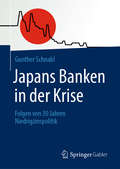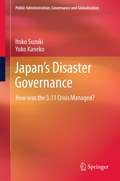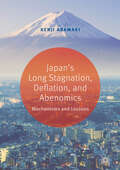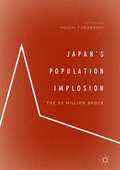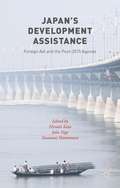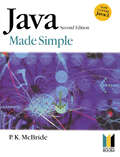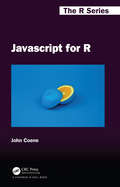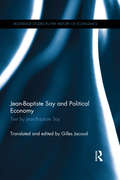- Table View
- List View
Japanese Views on Economic Development: Diverse Paths to the Market (Routledge Studies In The Growth Economies Of Asia)
by Kenichi Ohno Izumi OhnoThis newly revised clearly-presented text looks at Japan's economic history from the nineteenth century through to World War II. Within a framework based on the theories and approaches of Development Studies, it demonstrates the relevance of Japan's pre-war experience to the problems facing developing countries today, and draws out the historical r
Japanese Women Poets: An Anthology
by Hiroaki SatoThroughout history, Japanese women have excelled in poetry - from the folk songs of the Kojiki (Record of Ancient Matters) compiled in 712 and the court poetry of the 9th to the 14th centuries, on through the age of haikai and kanshi to the 19th century, into the contemporary period when books of women's poems have created a sensation.This anthology presents examples of the work of more than 100 Japanese women poets, arranged chronologically, and of all the major verse forms: choka, tanka, haikai (haiku), kanshi (verse written in Chinese), and free verse. The poems describe not just seasonal changes and the vagaries of love - which form the thematic core of traditional Japanese poetry - but also the devastations of war, childbirth, conflicts between child-rearing and work, experiences as refugees, experiences as non-Japanese residents in Japan, and more.Sections of poetry open with headnotes, and the editor has provided explanations of terms and references for those unfamiliar with the Japanese language. Other useful tools include a glossary of poetic terms, a chronology, and a bibliography that points the reader toward other works by and about these poets. There is no comparable collection available in English.Students and anyone who appreciates poetry and Japanese culture will treasure this magnificent anthology. Editor and translator Hiroaki Sato is a past winner of the PEN America translator prize and the Japan-United States Friendship Commission's 1999 literary translation award.
Japanese Women in Leadership (Current Perspectives on Asian Women in Leadership)
by Gary N. McLean Yoshie Tomozumi Nakamura Mayuko HorimotoThis edited book highlights the unique cultural and socioeconomic elements of Japan and the strong influence of those elements on women leaders in the nation. It shows that gender inequality and under-utilization of female talent are deeply rooted in Japanese society, explaining why Japan lags behind other countries in Asia in this regard. The contributors are expert academicians and practitioners with a clear understanding of Japanese women leaders' aspirations and frustrations. This book has critical implications for the development of women leaders in Japan, providing intriguing insights into developing the potential of highly qualified women leaders in diverse Japanese contexts in which traditional cultural expectations and modernized values coexist.
Japanese Workers in Protest: An Ethnography of Consciousness and Experience
by Christena L. TurnerThis first ethnographic study of factory workers engaged in radical labor protest gives a voice to a segment of the Japanese population that has been previously marginalized. These blue-collar workers, involved in prolonged labor disputes, tell their own story as they struggle to make sense of their lives and their culture during a time of conflict and instability. What emerges is a sensitive portrait of how workers grapple with a slowed economy and the contradictions of Japanese industry in the late postwar era. The ways that they think and feel about accommodation, resistance, and protest raise essential questions about the transformation of labor practices and limits of worker cooperation and compliance.
Japanese and German Enterprises: Comparison of Industrial Cocentration System and Business Management
by Toshio YamazakiThe objective of this book is to analyze and compare the processes of corporate expansion of postwar Japan and Germany. It examines the evolution of distinctive Japanese and German business management styles through the adoption of American management methods, thereby establishing a system of industrial concentration in contrast to the US de-concentration policy. This is the first time that the book draws on a range of topics related to business administration, including the concentration of enterprises, management and production systems, management education, marketing, organizational structure, and corporate governance. The book compares the Japanese and German models. Japanese enterprises developed a management style that was suitable for American and Japanese markets, in part due to the underdeveloped Asian markets. Meanwhile, German enterprises established a management style for European markets. The book considers the specificities of the Japanese management model, predicated on thorough cost reduction and few product defects. In contrast, the German management model placed a premium on differentiation based on product quality and functionality, with a particular focus on core markets and the skills of the workforce. The book posits that corporate expansion was a determining factor in the regionalization of each country. Japan underwent a transformation toward "Asianization," which depended on production and markets in Asia after the 1990s. Germany, on the other hand, consistently pursued "Europeanization" after the war in two complementary ways: (1) a heavy reliance on the European region and (2) the endeavor to advance European integration. Transformations in business management are analyzed using the author's two original frameworks: (1) The term "total system of business management" denotes the fundamental conditional structures that regulate and define the established methods of business management within the confines of capitalism in a specific country. (2) The term "reframing" is used to explain the adaptation, modification, and adjustment of one country's particular management style to another nation. These arguments reframe how we understand the historical processes of corporate expansion and provide milestones for a comparative study of management through common factors and characteristics of management.
Japanese-Style Management Transferred: The Experience of East Asia (Routledge Library Editions: Japan)
by K J FukudaJapan’s rapid rise to economic super-power status has led to a worldwide interest in and attempts to emulate Japanese management practices. This book, based on extensive original research, considers both the opportunities and problems of the transfer of Japanese management practices to other areas in East Asia. It remains one of the few books of its kind, as other books on Japanese management have concentrated on its transferability to the West. Because many Japanese subsidiaries have been established longer in East Asia than elsewhere and the local work forces have become accustomed to Japanese management practices when transferred elsewhere have become apparent in a way they have not where Japanese management practices are much newer.
Japans Banken in der Krise: Folgen von 30 Jahren Niedrigzinspolitik
by Gunther SchnablSeit dem Platzen der japanischen Blasenökonomie im Dezember 1989 befindet sich Japan in einer langanhaltenden Rezession. Die geldpolitische Krisentherapie wurde durch Zinssenkungen auf zuletzt unter null sowie groß angelegte Ankäufe von Vermögenswerten, insbesondere von Staatsanleihen durch die Zentralbank bestimmt. Schnabl analysiert die vielfachen Auswirkungen auf die japanischen Banken mit Fokus auf die kleinen und mittleren Regionalbanken. Nicht nur der Verfall der Vermögenspreise nach Platzen der japanischen Blasenökonomie, sondern auch die geldpolitische Krisentherapie selbst haben den Banken geschadet. Schrumpfende Zinsüberschüsse, der Rückgang der Kreditnachfrage sowie die geringe Verzinsung von Staatsanleihen haben die Gewinnmöglichkeiten der Banken erodiert. Das Buch zeigt, wie sich die japanischen Banken durch Kostensenkungen, Fusionen, veränderte Geschäftsmodelle und nachsichtige Kreditvergabe an die ultra-lockere Geldpolitik der Bank von Japan angepasst haben und sich auch weiter werden anpassen müssen.
Japan’s Disaster Governance
by Yuko Kaneko Itoko SuzukiNatural disasters are often multifaceted and cause severe damage. Disasters initiated locally can become national and even global crises. Today's world urgently needs a new body of knowledge and techniques for the mitigation of and response to disaster. Central to such a body of knowledge are disaster preparedness, emergency and crisis management systems of government, of which capacity building is becoming an increasingly important element in public administration, management and governance. Today, disasters are to be managed by sound local, national, and global governance, through all the phases of preparedness, prevention, mitigation and then to relief, recovery and re-construction. During all these phases, government plays the most important role. This book provides a case of the disaster governance of Japan, by presenting information and analyses on what happened in the Magnitude 9 Great East Japan Earthquake that caused the huge tsunami and the INES Level 7 Fukushima nuclear power plants accidents on March 11, 2011. In examining this Japanese case study, this book illustrates the socio-economic damage of the stricken areas together with the overall picture of the disasters. It examines Japan's capacity for disaster governance and it's crisis management system in response to the most devastating disaster that the country has ever encountered since the end of WWII. It also offers preliminary findings learned from this experience in the Japan's public administration and governance systems, challenged to be more accountable and transparent during the recovery and reconstruction efforts now in progress.
Japan’s Financial Slump
by Yasushi SuzukiThis book evaluates the salient features of Japanese relation-based banking, particularly in the post war period, and Anglo-American mode of banking to explain the nature and extent of transition failure that caused prolonged financial and economic slump in Japan.
Japan’s Financial System: New Perspectives and Potential Risks in the Post-Global Financial Crisis Era (Hitotsubashi University IER Economic Research Series #49)
by Tokuo IwaisakoThis book is a collection of papers from the Tokyo Center for Economic Research's (TCER) research project on Japan's financial markets and financial system, including: (1) Current Japanese situation of cashless payments for individuals and households, (2) The possibility that digital currencies replace the current payment system in which the banking system provides the means of credit transactions, (3) Long-turn measurement of the value added generated by Japan's financial intermediaries, with an overview of Japanese banking industry’s business model, (4) Regional financial institutions' recent efforts to support their clients’ businesses by consultation, (5) The impact of the digitalization of stock trading on the Japanese market: factor investing and high-frequency trading (HFT), (6) Analysis of theoretical and real-world portfolio allocations based on the concepts of model uncertainty and ambiguity aversion, (7) An empirical analysis on ESG investment in Japan, focusing on the heterogeneity of institutional investors, (8) Japanese firms’ corporate governance: financial vs internal governance, (9) Japanese companies’ use of corporate insurance as a company-wide decision-making process, (10) The coexistence of zombie firms and debt-free healthy firms since the 1990s. (11) The validity of Japanese government's liquidity provision for troubled firms during the financial crisis and the Covid-19 crisis. This is an open access book.
Japan’s Foreign Aid Policy in Africa: Evaluating the TICAD Process
by Pedro Amakasu RaposoJapan's Foreign Aid Policy in Africa seeks to evaluate TICAD's intellectual contribution to and its development practices regarding Africa over the past 20 years. A central conclusion is that, while TICAD bureaucrats lacked agency to support Japanese companies in Africa, the model of emerging powers partnerships has expanded in Africa.
Japan’s Long Stagnation, Deflation, and Abenomics: Mechanisms and Lessons
by Kenji AramakiThis book examines the struggles of the Japanese economy over the last 30 years, analyzing in detail the formation of the huge economic bubble in the 1980s, its collapse at the beginning of the 1990s, and subsequent two decade long economic stagnation and chronic deflation, with the aim of identifying the mechanism of such processes and drawing lessons for future economic policy management. The book also assesses the comprehensive policy efforts called “Abenomics” under the current Abe administration. As Abe continues into a new term, this book will be of interest to Japan scholars, economists, and policymakers around the world, particularly in Asia.
Japan’s Population Implosion
by Yoichi FunabashiThis cutting edge collection examines Japan's population issue, exploring how declining demographic trends are affecting Japan's social structure, specifically in the context of Greater Tokyo, life infrastructure, public finance and the economy. Considering the failures of past Japanese policies from the perspective of population, national land, and politics, it argues that the inability of past administrations to develop a long-term and comprehensive policy has exacerbated the population crisis. This text identifies key negative chain reactions that have stemmed from this policy failure, notably the effect of population decline on future economic growth and public finances and the impact of shrinking municipalities on social and community infrastructure to support quality of life. It also highlights how population decline can precipitate inter-generational conflict, and impact on the strength of the state and more widely on Japan's international status. Japan is on the forefront of the population problem, which is expected to affect many of the world's advanced industrial economies in the 21st century. Based on the study of policy failures, this book makes recommendations for effective population policy - covering both 'mitigation' measures to encourage a recovery in the depopulation process as well as 'adaptation' measures to maintain and improve living standards - and provides key insights into dealing with the debilitating effects of population decline.
Japan’s Public Policy Companies
by Chalmers JohnsonA provocative study of the government-business relationship in Japan and why it works so well.
Japan�s Development Assistance: Foreign Aid And The Post-2015 Agenda
by John Page Hiroshi Kato Yasutami ShimomuraJapan's Development Assistance
Japan�s Great Stagnation and Abenomics
by Masazumi WakatabeAs the global Great Recession continues, policymakers, economists, and the public are turning to Japenses economic revitalization for answers. Paul Krugman, Nobel laureate in Economics, once said that Japan was a 'full-dress rehearsal for the current crisis. ' Japan has experienced and valiantly overcome the burst of their Bubble economy, financial crisis, lukewarm recovery, and more than a decade-long deflation and stagnation to become one of the most stable economies today. Japan's Great Stagnation and Abenomics chronicles Japan's Great Stagnation and reveals the striking similarities of economic events and policies between the Great Stagnation and the current Great Recession. It also suggests possible dangers ahead and way-outs in the future. This exciting new volume is based on Wakatabe's expertise in economic history and the history of economic ideas and argues that any policy decision is related to cultural ideology. An investigation into the relationshipbetween cultural ideology and policy helps us better understand the policy-making process.
Jatropha curcas L: Agronomy, Biotechnology, Biodiesel and Byproducts (Environmental Science and Engineering)
by Kamrun NaharThis book addresses the opportunity to cultivate a multipurpose, drought resistant and nonfood bioenergy crop, Jatropha curcas L. in Bangladesh. As a renewable resource and a sustainable substitute for fossil fuel, Jatropha curcas produces seeds containing inedible oil, which can supply fuel and meet the national energy demands of Bangladesh. The plant does not need arable lands and does not compete with food, water and nutrients. This book also highlights the land use patterns and possible cultivation areas of Bangladesh. It is based on research of the cultivation technology, ecological and agronomical aspects, biotechnological methodologies, harvesting and crop yield including fuel and byproduct formation. It also highlights the different uses and socioeconomic benefits of the plant and production costs and briefly describes the procedure for the production of biodiesel and other useful byproducts. The comparison of biodiesel from Jatropha curcas with conventional fossil fuel is also discussed as well as its ability to sequester carbon from the environment to cope up with climate change, adaptation as well as mitigation
Java Made Simple
by P K McbrideJava is a programming language designed for use on networks, in particular the Internet, and can also be used to write full-scale applications. It is based upon C++ and is very similar in its style and structure. Java Made Simple 2nd edition concentrates on getting the reader started and assumes no prior programming knowledge. Once the essentials have been mastered, it provides the confidence to go deeper into the language and broaden and develop invaluable programming skills.
Javascript for R (Chapman & Hall/CRC The R Series)
by John CoeneLittle known to many, R works just as well with JavaScript—this book delves into the various ways both languages can work together. The ultimate aim of this work is to put the reader at ease with inviting JavaScript in their data science workflow. In that respect the book is not teaching one JavaScript but rather we show how little JavaScript can greatly support and enhance R code. Therefore, the focus is on integrating external JavaScript libraries and no prior knowledge of JavaScript is required. Key Features: ● Easy to pick up. ● An entry way to learning JavaScript for R. ● Covers topics not covered anywhere else. ● Easy to follow along.
Javatrekker: Dispatches from the World of Fair Trade Coffee
by Dean CyconIn each cup of coffee we drink the major issues of the twenty-first century-globalization, immigration, women's rights, pollution, indigenous rights, and self-determination-are played out in villages and remote areas around the world. In "Javatrekker: Dispatches from the World of Fair Trade Coffee," a unique hybrid of Fair Trade business, adventure travel, and cultural anthropology, author Dean Cycon brings readers face-to-face with the real people who make our morning coffee ritual possible. Second only to oil in terms of its value, the coffee trade is complex with several levels of middlemen removing the 28 million growers in fifty distant countries far from your morning cup. And, according to Cycon, 99 percent of the people involved in the coffee economy have never been to a coffee village. Cycon changes that in this compelling book, taking the reader on a tour of ten countries in nine chapters through his passionate eye and unique perspective. Cycon, who is himself an amalgam-equal parts entrepreneur, activist, and mischievous explorer-has traveled extensively throughout the world's tropical coffeelands, and shows readers places and people that few if any outsiders have ever seen. Cycon introduces us to the Mamos of Colombia-holy men who believe they are literally holding the world together-despite the severe effects of climate change caused by us, their "younger brothers. " He takes us on a trip through an ancient forest in Ethiopia where many believe that coffee was first discovered 1,500 years ago by the goatherd Kaldi and his animals.
Jay Gould, "The Most Hated Man in America"
by Matthew Preble Tom Nicholas John MaskoRailroad magnate Jay Gould, a controversial figure in the history of U.S. capitalism, was a disruptive influence on an industry that had previously relied on formal and informal agreements to move traffic long distances across lines operated by different companies. Gould and his competitors replaced these agreements with consolidation and system-building, a process which led to the rise of government regulation of railroads in the 1880s and to widespread railroad bankruptcies in the 1890s. This case explores the growth of early American railroads, places Gould's career in context (including his famous attempt to corner the U.S. gold market), and demonstrates the implications of his activities on competitive dynamics in the railroad industry.
Jean de Grandpré: Legacy of a Giant
by Danielle Stanton Hervé AnctilVisionary leader and businessman Jean de Grandpré has earned many nicknames: he is known variously as the Simplifier, the Architect, and the Strategist. A lawyer when he joined Bell Canada in 1966, he went on to build a telecommunications empire that spanned the continent, crossing paths with politicians, moguls, and philanthropists along the way.Beginning as Bell’s general counsel, de Grandpré quickly rose through the corporate ranks and became president in 1973. A few years later he created Bell Canada Enterprises, one of America’s largest telecommunications companies. A globally recognized manager and director, he has served on the boards of numerous companies, both in Canada and abroad. As generous as he is discreet, he is involved with several charities, including the Papillon Foundation, which helps disabled children. At McGill University, his alma mater, De Grandpré served as chancellor from 1984 to 1991 and is now governor emeritus and chancellor emeritus.Danielle Stanton and Hervé Anctil retrace the admirable career of this influential man whose life has spanned a century. Offering insight into the secrets of his success, Jean de Grandpré will inspire new generations of entrepreneurs.
Jean-Baptiste Say and Political Economy: Or The Production, Distribution, And Consumption Of Wealth. By Jean Baptiste Say. Tr. From The 4th Ed. Of The French (Routledge Studies in the History of Economics)
by Jean-Baptiste SayJean-Baptiste Say (1767–1832) was one of the first great economists to have laid down the foundations of economic science. Author of the famous Treatise on Political Economy in 1803, which was revised and re-edited on several occasions, he published numerous other works including a voluminous Complete Course in Practical Political Economy in 1828–9. He also taught political economy successively from 1815 until his death in three Parisian establishments: the Athénée, the Conservatory of Arts and Trades, and the Collège de France. <P><P> The texts in which Say exposes his approach to political economy have not been available in the English language until now except for the fourth edition of the ‘Preliminary Discourse’ which serves as an introduction to the Treatise. This book presents a translation which renders his works accessible to the English speaking world. For the first time, English readers will be able to become directly immersed in Say’s principal texts, where he develops his conception of political economy. Jean-Baptiste Say and Political Economy proposes a translation of a selection of eleven of Say’s texts. The first three are versions of the ‘Preliminary Discourse’ from the Treatise’s editions of 1803, 1814 and 1826 with the variations of the editions of 1817, 1819 and 1841. The following four texts are the opening discourses pronounced at the Conservatory in 1820 and 1828 and the Collège de France in 1831 and 1832. The eighth text is the ‘General Considerations’ which open the Complete Course in Practical Political Economy of 1828, with the variations of the 1840 re-edition. The final three texts are those Say devotes to ‘the progress of political economy’ in what is akin to a history of economic thought. <P><P> This volume is of great importance to economic historians and people studying Jean-Baptiste Say, as well as those who are interested in economic theory and philosophy and political economy.






